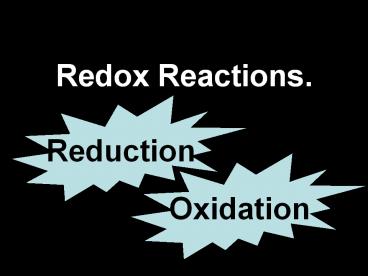Redox Reactions. - PowerPoint PPT Presentation
Title:
Redox Reactions.
Description:
Redox Reactions. Reduction Oxidation GCSE 4 Experiments: Burning magnesium Copper in silver nitrate solution Chlorine solution and potassium iodide solution Exploding ... – PowerPoint PPT presentation
Number of Views:619
Avg rating:3.0/5.0
Title: Redox Reactions.
1
Redox Reactions.
Reduction
Oxidation
2
GCSE
- Oxidation
- Gain of oxygen
- Loss of electrons
- Reduction
- Loss of oxygen
- Gain of electrons
Increase in oxidation number
Decrease in oxidation number
3
4 Experiments
- Burning magnesium
- Copper in silver nitrate solution
- Chlorine solution and potassium iodide solution
- Exploding hydrogen
- Word equation
- Balanced symbol equation
4
2Mg(s) O2(g) ? 2MgO(s)
Oxidised gains oxygen
Must be a redox!
Mg ? Mg2
Oxidised loss of e-
2e-
Put the e- in.
O ? O2-
Reduced gain of e-
2e-
5
Cu(s) 2AgNO3(aq) ? Cu(NO3 )2(aq) 2Ag(s)
Complete the half-equations
Oxidised? Reduced?
Cu ? Cu2
Oxidised loss of e-
2e-
Ag ? Ag
Reduced gain of e-
e-
6
Try Question 1.
7
H2(g) ½ O2(g) ? H2O(g)
Covalent!
Need a new definition.
No H or OH-
8
GCSE
- Oxidation
- Gain of oxygen
- Loss of electrons
- Reduction
- Loss of oxygen
- Gain of electrons
Increase in oxidation number
Decrease in oxidation number
9
Oxidation Numbers
- The oxidation number of an atom in an element is
zero. E.g. Mg in Mg, O in O2.
10
Oxidation Numbers
- The oxidation numbers of atoms in a compound add
up to zero.
F -1
O -2
H 1
Cl -1
Oxidation state of C in CO2? ? 4 0 ? 4
Put the !
11
Oxidation Numbers
- The oxidation numbers of atoms in a compound add
up to zero.
F -1
O -2
H 1
Cl -1
Oxidation state of Mg in MgCl2?
2
12
Oxidation Numbers
- The oxidation numbers of atoms in a compound add
up to zero.
F -1
O -2
H 1
Cl -1
Oxidation state of N in NH3?
-3
13
Oxidation Numbers
- The oxidation numbers of atoms in an ion add up
to the charge on the ion.
F -1
O -2
H 1
Cl -1
Oxidation state of S in SO42-? ? 8 -2 ? 6
14
Oxidation Numbers
- The oxidation numbers of atoms in an ion add up
to the charge on the ion.
F -1
O -2
H 1
Cl -1
Oxidation state of S in S2-?
-2
15
Oxidation Numbers
- The oxidation numbers of atoms in an ion add up
to the charge on the ion.
F -1
O -2
H 1
Cl -1
Oxidation state of N in NH4?
-3
16
Try Question 2.
17
H2(g) ½ O2(g) ? H2O(g)
Covalent!
Need a new definition.
No H or OH-
18
GCSE
- Oxidation
- Gain of oxygen
- Loss of electrons
- Reduction
- Loss of oxygen
- Gain of electrons
Increase in oxidation number
Decrease in oxidation number
19
H2(g) ½ O2(g) ? H2O(g)
Covalent!
1
H
0
O
-2
0
Need a new definition.
No H or OH-
20
H2(g) ½ O2(g) ? H2O(g)
1
H
0
O
-2
0
Oxidised?
Reduced?
O decrease in oxidation number
H increase in oxidation number
21
Try Question 3.
22
Oxidation Numbers and names
- To avoid any confusion when an element can have
several oxidation numbers, the oxidation number
is usually mentioned in the compounds name. In
names like elementate(X), the number refers to
element and not the associated oxygens. - So if we look at some examples , we get the
following names- - KMnO4 potassium manganate(VII)
- NaClO3 sodium chlorate(V)
- POCl2F phosphorus(V) oxydichlorofluoride
- NaH2PO3 sodium dihydrogenphosphate(III)
- K2Cr2O7 potassium dichromate(VI)
Check the numbers.
23
Try any 3 in Question 7.
24
Well done!
25
This powerpoint was kindly donated to
www.worldofteaching.com http//www.worldofteac
hing.com is home to over a thousand powerpoints
submitted by teachers. This is a completely free
site and requires no registration. Please visit
and I hope it will help in your teaching.

